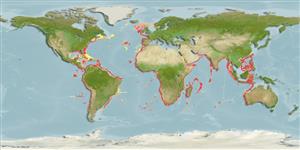Common names from other countries
>
Gadiformes (Cods) >
Macrouridae (Grenadiers or rattails)
Etymology: Malacocephalus: Greek, malakos = soft + Greek, kephale = head (Ref. 45335).
More on author: Lowe.
Environment: milieu / climate zone / depth range / distribution range
Ecologia
marinhas batidemersal; não migratória; intervalo de profundidade 200 - 1000 m (Ref. 1371), usually 300 - 750 m (Ref. 3587). Deep-water; 62°N - 43°S, 97°W - 124°E (Ref. 1371)
Atlantic, Indian and Pacific: Western Atlantic: Strait of Florida to Brazil, Gulf of Mexico and Caribbean Sea. Eastern Atlantic: Iceland (Ref. 12462) and Faroes to South Africa. Indian Ocean: Arabian Sea, Bay of Bengal, off Maldives and off East African coast. Western Pacific: Indonesian area and Australia. Eastern Central Pacific (Ref. 9315). Malacocephalus hawaiiensis, Malacocephalus luzonensis, and Malacocephalus nipponensis are closely related to Malacocephalus laevis and may eventually prove to represent populations of this species, if a comprehensive comparison of material from the Atlantic, Indian and Pacific oceans is done (Ref. 1371).
Tamanho / Peso / Idade
Maturity: Lm ? range ? - ? cm
Max length : 60.0 cm TL macho/indeterminado; (Ref. 2800); common length : 40.0 cm TL macho/indeterminado; (Ref. 26999)
Espinhos dorsais (total) : 2; Raios dorsais moles (total) : 229; Espinhos anais: 0. Head uniformly scaled, including the mandibles and the ventral aspects of the snout and suborbital. Snout blunt, its tip with a conical tubercle. The trunk is short, the body tapers abruptly from behind the first dorsal fin. The caudal fin is absent.
Found on continental slopes (Ref. 1371). Utilized mainly for fishmeal and oil (Ref. 1371). In the past, fishers in the North Atlantic were reported to have used the luminescent excretion from the ventral light organ to enhance baits used for cod fishing (Ref. 1371).
Life cycle and mating behavior
Maturities | Reprodução | Spawnings | Egg(s) | Fecundities | Larvas
Cohen, D.M., T. Inada, T. Iwamoto and N. Scialabba, 1990. FAO species catalogue. Vol. 10. Gadiform fishes of the world (Order Gadiformes). An annotated and illustrated catalogue of cods, hakes, grenadiers and other gadiform fishes known to date. FAO Fish. Synop. 125(10). Rome: FAO. 442 p. (Ref. 1371)
Categoria na Lista Vermelha da IUCN (Ref. 130435)
CITES (Ref. 128078)
Not Evaluated
Ameaça para o homem
Harmless
Utilização humana
Pescarias: pouco comercial
Ferramentas
Relatórios especiais
Descarregue XML
Fontes da internet
Estimates based on models
Preferred temperature (Ref.
115969): 6.1 - 13.9, mean 9.5 (based on 824 cells).
Phylogenetic diversity index (Ref.
82804): PD
50 = 0.5078 [Uniqueness, from 0.5 = low to 2.0 = high].
Bayesian length-weight: a=0.00129 (0.00075 - 0.00222), b=3.14 (2.99 - 3.29), in cm Total Length, based on LWR estimates for this species & (Sub)family-body (Ref.
93245).
Nível Trófico (Ref.
69278): 3.8 ±0.56 se; based on food items.
Resiliência (Ref.
120179): Muito baixo, tempo mínimo de duplicação da população maior que 14 anos (Preliminary K or Fecundity.).
Fishing Vulnerability (Ref.
59153): Moderate vulnerability (44 of 100).
